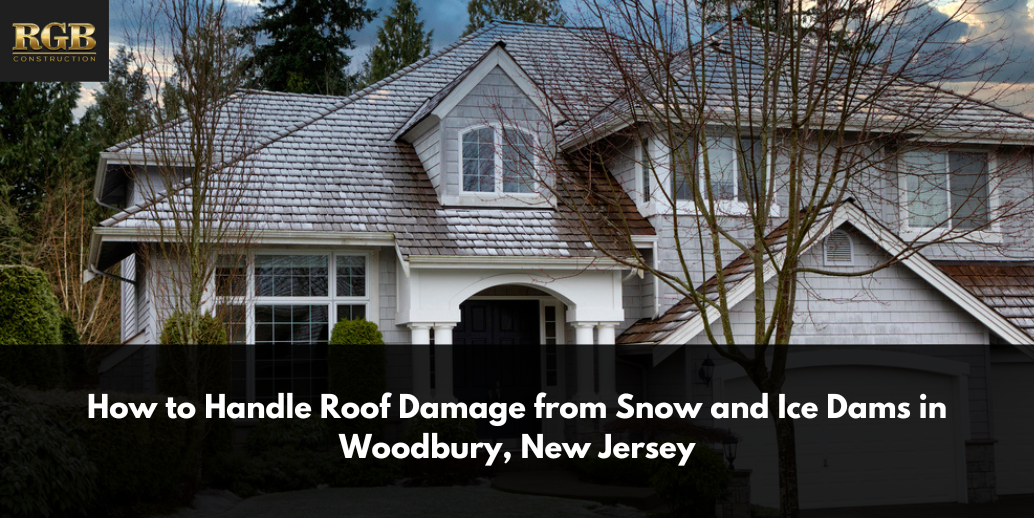Winter in Woodbury, NJ, brings its own set of challenges for homeowners, particularly when it comes to roof maintenance. Snow and ice dams can cause significant damage to your roof, leading to costly repairs if not addressed promptly. Therefore, knowing what can happen if ice dams form, as well as how to deal with snow and ice effectively, is a critical piece of knowledge all Woodbury homeowners should have. Here’s a comprehensive guide on how to handle roof damage from snow and ice dams to protect your home during the winter months.
Key Takeaways
- Ice dams form when heat from your home melts snow on the roof, which refreezes at the eaves, causing water to back up under shingles and potentially lead to leaks and water damage.
- Clear excess snow with a roof rake, safely remove ice dams using calcium chloride, and address any leaks quickly by containing water and relieving pressure.
- Schedule annual roof inspections, check and repair shingles and flashing, clean gutters and downspouts, and trim overhanging branches to prevent roof damage from snow and ice.
- Contact a roofing contractor like RGB Construction for thorough inspections, necessary repairs, and the installation of preventive solutions such as heat cables and de-icing systems.
What is an Ice Dam?
During the winter when snow is falling, ice dams can form. How, exactly? When the temperature dips and the heater within your home is running constantly, it is possible that snow on the roof can melt. That heat escapes, leaving the melted snow to run down the colder eaves, where it refreezes, creating a blockage. This blockage prevents further melting snow from draining off the roof, causing water to back up under the shingles and potentially lead to leaks and water damage inside your home.
Immediate Steps to Take Against Ice Dams
If you notice an ice dam forming or suspect roof damage from snow and ice, take the following immediate steps:
- Clear Excess Snow: Use a roof rake to carefully remove excess snow from your roof. Be sure to stand on the ground and use a long-handled rake to avoid damaging the shingles or injuring yourself.
- Remove Ice Dams Safely: Avoid hacking away at the ice with sharp tools, as this can damage your shingles. Instead, consider using a calcium chloride ice melt product to safely dissolve the ice. Place the ice melt in a nylon stocking and position it vertically across the ice dam to create a channel for water to drain.
- Address Leaks Quickly: If you notice water leaking into your home, contain the leak with buckets and towels, and address the source immediately. Poke a small hole in the ceiling where the water is pooling to allow it to drain and relieve pressure.
How to Prevent Future Ice Dams
If you want to stop ice dams from forming, you need to take preventive steps. Here are some ways to go about that:
- Improve Attic Insulation: Ensure your attic is well-insulated to prevent heat from escaping through the roof. Proper insulation helps maintain a consistent roof temperature, reducing the likelihood of snow melting and refreezing at the eaves.
- Enhance Ventilation: Proper attic ventilation allows cold air to circulate under the roof, keeping the roof surface cold and preventing the formation of ice dams. Install ridge vents, soffit vents, and attic fans to improve airflow.
- Seal Air Leaks: Identify and seal any air leaks in your attic that could be allowing warm air to escape. Use caulk or spray foam to seal gaps around chimneys, vents, and other openings.
Regular Roofing Maintenance Helps
While it might not seem so, roof maintenance throughout the year can help prevent damage from snow and ice dams. Schedule annual inspections to ensure your roof is in good condition and address any issues before they become major problems. You should also do the following:
- Inspect Shingles and Flashing: Check for loose or damaged shingles and ensure flashing around chimneys and vents is secure. Replace any damaged materials to prevent water infiltration.
- Clean Gutters and Downspouts: Ensure your gutters and downspouts are clean and free of debris. Proper drainage prevents water from backing up and freezing at the roof’s edge.
- Trim Overhanging Branches: Trim any tree branches that hang over your roof to prevent them from depositing additional snow and debris onto your roof.
Consider Getting Preventing Professional Help For Ice Dam Damages
Sometimes, handling roof damage from snow and ice dams requires professional assistance. If you’re unsure about the extent of the damage or how to address it safely, contact a local roofing contractor like RGB Construction. A professional contractor can conduct a thorough inspection to identify any damage and recommend necessary repairs. While this may not happen in winter, you can have this done before the colder months to find damages before they worsen during the freeze-thaw cycle.
Furthermore, experienced contractors can efficiently repair or replace damaged shingles, flashing, and other roofing components to restore your roof’s integrity. Professionals can also install preventive solutions such as heat cables or roof de-icing systems to keep ice dams from forming in the first place.
Contact a Woodbury Roofing Contractor Today
Handling roof damage from snow and ice dams in Woodbury, NJ, requires a combination of immediate action, preventive measures, and regular maintenance. By taking steps to prevent ice dams and addressing any damage promptly, you can protect your home from the harsh effects of winter weather. For professional assistance, contact RGB Construction, your trusted local roofing contractor, to ensure your roof remains in top condition all year round.







